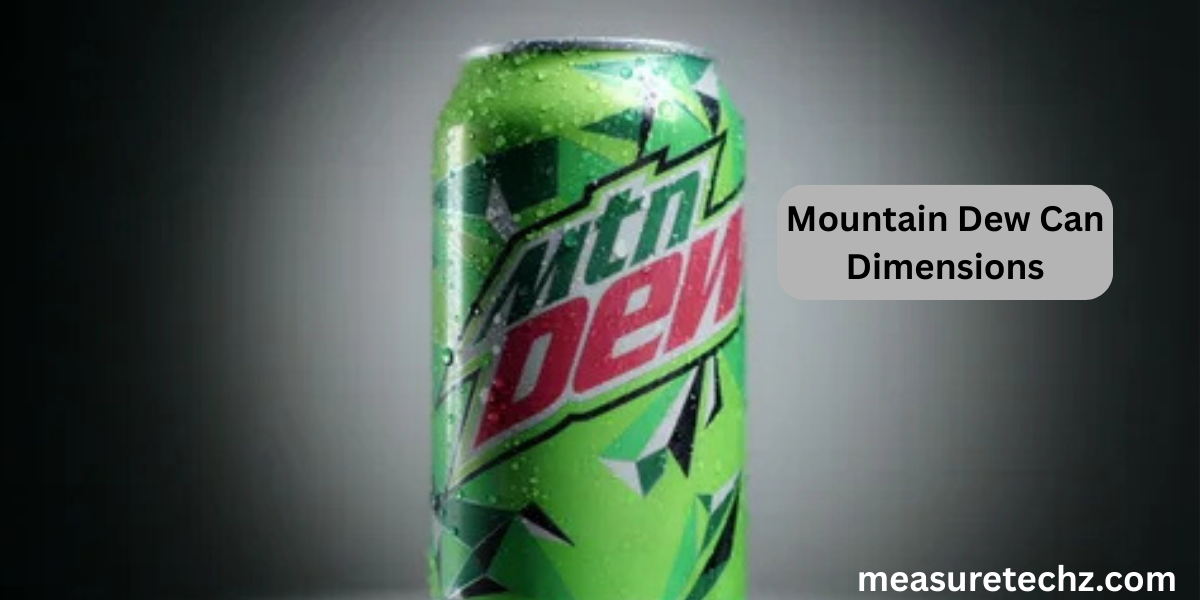Picture this: you’re at a gas station, craving something refreshing, and you grab a can of Mountain Dew. You crack it open, hear that familiar fizz, and take your first sip. But have you ever paused to wonder — what exactly are the dimensions of the can in your hand?
It’s one of those everyday items we rarely question. Yet the height, diameter, and overall size of a Mountain Dew can are carefully designed with purpose. Whether you’re stocking a vending machine, designing a fridge organizer, running a business that needs precise packaging, or just a curious soda fan, knowing the dimensions can be surprisingly useful.
This article is your complete guide to Mountain Dew can dimensions. We’ll cover every size available — from mini cans to tallboys, break down the exact measurements, compare them with other soft drinks, explore why cans are designed the way they are, and answer every question you might have. By the end, you’ll know more about Mountain Dew cans than most people ever will.
The Standard Mountain Dew Can: The 12 oz Classic
When most people think of Mountain Dew, they picture the 12-ounce (355 ml) can. It’s the standard size sold in six-packs, twelve-packs, and vending machines across the U.S.
Here are the exact dimensions:
- Capacity: 12 fluid ounces (355 ml)
- Height: 4.83 inches (12.3 cm)
- Diameter (top and bottom): 2.6 inches (6.6 cm)
- Circumference: 8.2 inches (20.8 cm)
- Weight (empty): ~15 grams of aluminum
This standardization makes it interchangeable with Pepsi, Coke, and most other sodas sold in the U.S. It’s designed to fit in vending machines, cup holders, and can storage racks without issue.
The Full Range of Mountain Dew Can Dimensions
Mountain Dew isn’t just sold in the classic 12 oz size. Like its bold flavors, the brand offers a variety of packaging sizes to meet different needs. Here’s a detailed breakdown:
7.5 oz Mini Can
- Height: 3.1 inches (7.9 cm)
- Diameter: 2.25 inches (5.7 cm)
- Best For: Portion control, parties, kids, calorie-conscious drinkers
These “mini cans” are great for when you want the flavor without committing to a full 12 ounces.
8.4 oz Slim Can
- Height: 4.8 inches (12.2 cm)
- Diameter: 2.1 inches (5.3 cm)
- Best For: Specialty packs, limited-edition flavors, energy-drink style appeal
This slimmer design is often used for Mountain Dew Energy or other spin-off drinks.
12 oz Standard Can
We already covered this one, but it’s worth noting that it’s the backbone of the soda industry.
16 oz Tall Can
- Height: 6.2 inches (15.7 cm)
- Diameter: 2.7 inches (6.8 cm)
- Best For: Road trips, single-serve convenience
These are slightly taller and give you more soda without being overwhelming.
24 oz Tallboy Can
- Height: 7.6 inches (19.3 cm)
- Diameter: 3 inches (7.6 cm)
- Best For: Long-lasting drinks, collectors, limited editions
These giant cans are often found in gas stations and are popular with fans who want more in a single serving.
International Variations
- 330 ml Can (common in Europe)
- 440 ml Can (UK)
- 500 ml Can (sometimes available in Asia and Europe)
These sizes are slightly different due to regional standards and consumer preferences.
Why Are Mountain Dew Cans Designed This Way?
The size and shape of a Mountain Dew can aren’t random. They’re the result of decades of testing and refinement. Here’s why:
- Comfort and Ergonomics – A can should fit naturally in your hand.
- Stacking and Storage – Uniform cans make it easy to stack in cases, fridges, and vending machines.
- Material Efficiency – Aluminum cans are pressurized containers. Their exact dimensions ensure strength while using minimal material.
- Global Compatibility – Machines, cup holders, and packaging systems are built around standardized can sizes.
- Branding Opportunity – The tall, slim, or short shapes help brands stand out visually.
Comparing Mountain Dew Cans to Other Soda Cans
Mountain Dew cans are dimensionally identical to Pepsi and Coca-Cola cans of the same size. This is intentional — standardization keeps the industry running smoothly.
However, Mountain Dew stands out in that it leans heavily into larger can sizes (16 oz and 24 oz tallboys) more than some other soda brands. This aligns with its high-energy image and loyal fanbase.
Benefits of Knowing Mountain Dew Can Dimensions
This might feel like trivia, but in real life, knowing the dimensions can make a big difference.
- Storage Planning: Custom fridge inserts, racks, and vending machine stocking rely on exact sizes.
- Crafting and DIY: Soda cans are often repurposed for science projects, art, or even survival gear.
- Health and Dieting: Portion control depends on choosing the right can size.
- Business Efficiency: Restaurants and bars stock and price based on container dimensions.
- Collecting: Can collectors use measurements to identify rare or international editions.
Common Misconceptions About Can Sizes
- “All cans are the same worldwide.”
False. U.S. 12 oz = 355 ml, but Europe’s “standard” is 330 ml. - “Slim cans are healthier.”
Not necessarily — they just hold less liquid, but per ounce, the nutrition is the same. - “Tall cans keep soda fizzier.”
Carbonation is determined by the formula, not the shape of the can.
Real-Life Examples: When Dimensions Matter
- Cup Holders: Designing a custom cup holder requires knowing that a 12 oz can is about 2.6 inches wide.
- Fridges: Tallboys may not fit in small dorm fridges.
- Science Class: Teachers use cans to demonstrate air pressure and volume.
- Travel: Choosing between a 16 oz and 24 oz can could determine how often you stop on a road trip.
Mistakes to Avoid
- Confusing ounces with milliliters – 12 oz is not the same as 330 ml.
- Ignoring can height – A 24 oz tallboy won’t fit everywhere.
- Thinking bigger is always better – A 24 oz can has nearly double the sugar of a standard can.
- Assuming all cup holders fit all cans – Slim cans may wobble, and wide cans may not fit.
Industry Insights: Trends in Can Packaging
The soda industry is shifting in interesting ways:
- Mini cans are rising – Health-conscious consumers want portion control.
- Slim cans are trendy – Especially among younger demographics.
- Sustainability is key – Aluminum cans are 100% recyclable and preferred over plastic.
- Limited editions create demand – Special can designs and sizes keep collectors engaged.
Tips for Choosing the Right Mountain Dew Can
- Daily drinking: Stick to the 12 oz classic.
- Diet-conscious: Grab 7.5 oz mini cans.
- On the go: 16 oz tallboys are portable but satisfying.
- Long sessions: 24 oz cans keep you fueled for longer stretches.
- Collecting: Look for international editions like 330 ml or 440 ml cans.
FAQs About Mountain Dew Can Dimensions
1. How tall is a 12 oz Mountain Dew can?
About 4.83 inches (12.3 cm).
2. What is the diameter of a standard Mountain Dew can?
Around 2.6 inches (6.6 cm).
3. Are Mountain Dew cans different from Pepsi or Coke cans?
No — they’re standardized.
4. What’s the largest Mountain Dew can size?
The 24 oz tallboy in the U.S., or 500 ml in some international markets.
5. Do can sizes affect carbonation?
No, the soda is the same regardless of can size.
6. How much does an empty Mountain Dew can weigh?
Around 14–15 grams of aluminum.
7. Why do other countries use 330 ml instead of 355 ml?
Different packaging standards — Europe favors 330 ml for convenience and portion control.
8. Do slim cans fit in standard cup holders?
Usually, but they may wobble since they’re narrower.
9. Can I recycle all Mountain Dew cans?
Yes, aluminum cans are fully recyclable.
10. Are there collectible Mountain Dew cans with unique dimensions?
Yes, especially limited-edition flavors and international releases.
Conclusion
Next time you hold a Mountain Dew can, look at it differently. Its dimensions — height, diameter, weight, and shape — are not random. They’re the result of careful engineering, consumer behavior, and global standardization.
Knowing these details can help you plan better, store more efficiently, and even appreciate the design behind something as simple as a soda can. Whether you’re a casual drinker, a collector, or just a curious mind, understanding Mountain Dew can dimensions adds a new layer of appreciation to something you encounter all the time.

